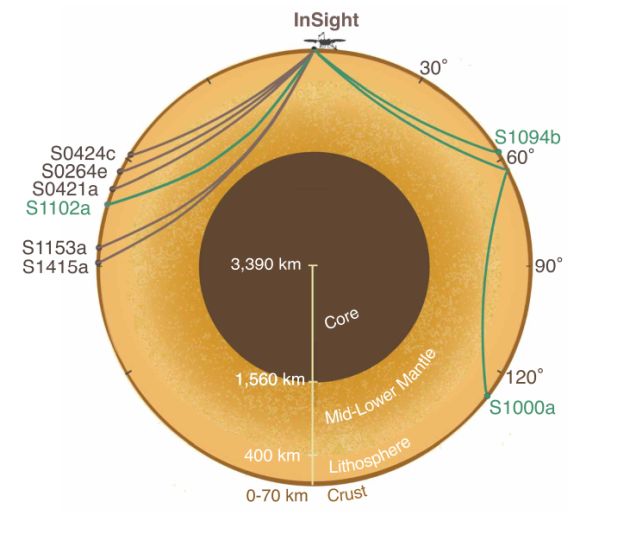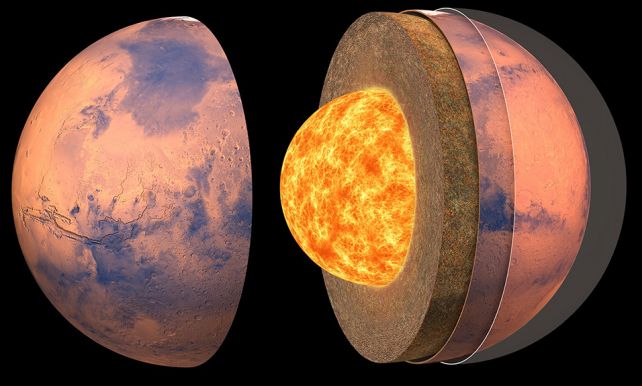The interior of Mars is as chunky as a delicious macadamia cookie.
A new analysis of the acoustic waves that ripple through and bounce around the red planet's guts reveals that the ancient, early crust of Mars is sequestered in its mantle. It takes the form of huge chunks of drifting rock, preserved geological fossils from the time of the planet's formation.
These chunks indicate a violent history that is startlingly similar to that suspected for Earth, involving a giant collision with a massive object while the planet was still young and forming.
Related: In an Incredible First, Scientists Have Discovered What's at The Core of Mars
Mars fascinates us because it is at once both like and unlike our own planet. The crust of Mars is, unlike the tectonic plates of Earth, one single piece. In addition, Mars doesn't have a global magnetic field, a feature of our home world generated by sloshing conductive material deep in Earth's center. This has led scientists to speculate about the structure of the Martian interior.

In the last few years, answers have finally begun to arrive. NASA sent a special instrument to Mars to sit on the surface and monitor the rumbles of seismic activity therein. Scientists can use the rumbles of quakes as a sort of acoustic X-ray to see what's inside a cosmic object.
Any quakes, or even rumbles from meteorite impacts, propagate outward from their point of origin, bouncing around inside a planet or moon or star before stilling to quietness. The way they travel through, and reflect off, certain materials allows scientists to generate maps of the interior compositions of these bodies.
During its relatively short time monitoring the interior of Mars from 2018 to 2022, NASA's InSight lander detected hundreds of marsquakes, giving us detailed information about the Martian interior. From this, scientists were able to compile the first detailed map of the guts of Mars, and learn more about Mars' interior activity.
Led by planetary scientist and engineer Constantinos Charalambous of Imperial College London, a team of scientists has now pored over data from eight clear events to reconstruct the composition of Mars' mantle – the gooey, squishy bit between the crust and the core – by studying the way seismic waves spread.

When they had crunched all the data, the researchers found giant fragments of material, some up to 4 kilometers (2.5 miles) across, surrounded by smatterings of smaller ones, preserved in the mantle of Mars from the time of its formation 4.5 billion years ago.
During this time, the Solar System was a chaotic mess, with large chunks of rock flying around and smashing into each other. The inner planets, including Earth, would have taken an absolute pummeling. It was during this time that scientists think a large object smacked into Earth, spraying planetary debris into space that then formed the Moon.
This bombardment, the researchers believe, disrupted the still-forming crust of Mars.
"These colossal impacts unleashed enough energy to melt large parts of the young planet into vast magma oceans," Charalambous says. "As those magma oceans cooled and crystallized, they left behind compositionally distinct chunks of material – and we believe it's these we're now detecting deep inside Mars."
After being whacked with space rocks, the researchers believe, the crust of Mars re-formed and sealed over the mantle, preserving the chunks within. Here on Earth, such chunks would be long gone by now; our crust and mantle are in constant motion, undergoing tectonic processes that constantly recycle them into each other.

Mars is a single-crust planet, and its interior evolution would be far more primitive and slow, retaining material like a time capsule from the birth of the Solar System.
"Most of this chaos likely unfolded in Mars's first 100 million years," Charalambous says. "The fact that we can still detect its traces after four and a half billion years shows just how sluggishly Mars's interior has been churning ever since."
This is in stark contrast to Earth, and a finding that gives us an invaluable data point for understanding the various ways rocky planets can evolve. Earth is the only planet in the Solar System with a crust divided into tectonic plates, so knowing more about Mars can also help us understand what's going on inside Mercury and Venus, whose interiors remain mysterious to us.
"Whereas Earth's early geological records remain elusive, the identification of preserved ancient mantle heterogeneity on Mars offers an unprecedented window into the geological history and thermochemical evolution of a terrestrial planet under a stagnant lid, the prevalent tectonic regime in our Solar System," the researchers write in their paper.
"This evolution holds key implications for understanding the preconditions for habitability of rocky bodies across our Solar System and beyond."
The research has been published in Science.
